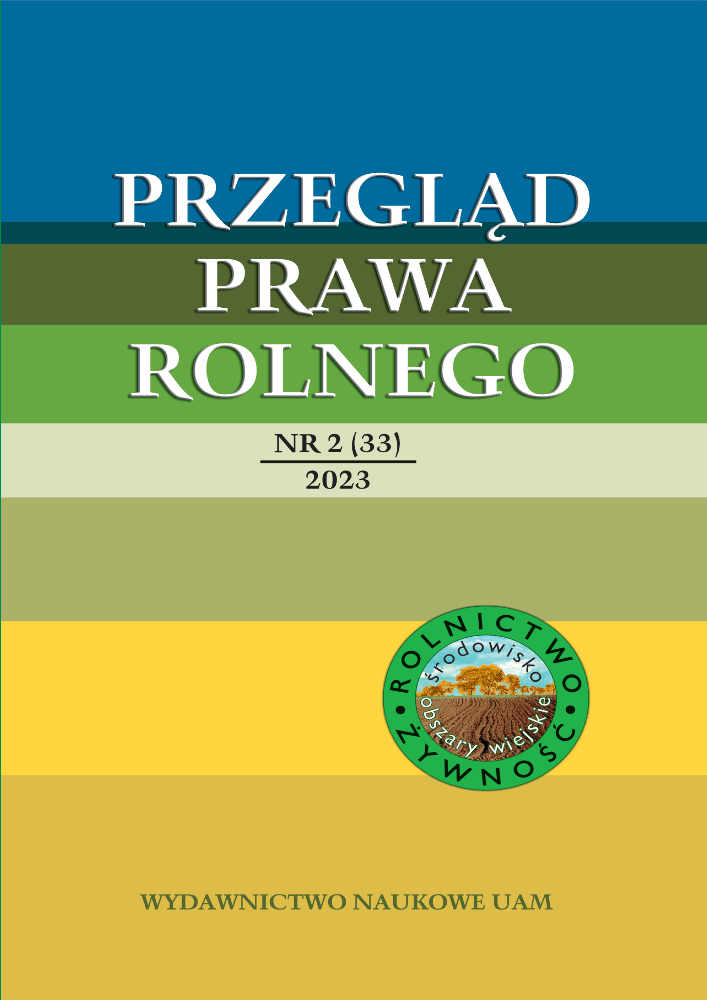Abstract
The aim of the article is to identify the possibility of creating legal solutions for the implementation of innovation in agriculture in the Polish and European legal system. The particular emphasis on the development of new technologies put in the Common Agricultural Policy after 2023 indicates that it is becoming one of the most important factors shaping the competitiveness and profitability of agriculture. It presupposes the development of a number of legal mechanisms that together will make up agricultural innovation. This heterogeneity is a major problem but at the same time an opportunity for agriculture. The article identifies first of all possible legal solutions, but emphasises that they cannot be developed without the cooperation of specialists from other scientific disciplines and representatives of business related to modern technologies. The definition of the legal framework for innovative solutions in agriculture cannot be separated from the consideration of global and European aspects. The speed and possibilities of the application of modern solutions will determine the place of Polish agriculture in the international arena for many years to come.
References
Baruk J. (2016), Wiedza i innowacje jako czynniki rozwoju organizacji — podejście zintegrowane, “Marketing Instytucji Naukowych i Badawczych” no. 3(29).
Brodziński Z., Juchniewicz M., Marks-Bielska R., Nasalski Z. (2022), Warunki rozwoju gospodarstw rolnych regionu Warmii i Mazur w kontekście Planu Strategicznego Wspólnej Polityki Rolnej na lata 2023–2027, Olsztyn. DOI: https://doi.org/10.24136/eep.mon.2022.7
Dou Y., Zagaria C., O’Connor L., Thuiller W., Verburg P.H. (2023), Using the Nature Futures Framework as a lens for developing plural land use scenarios for Europe for 2050, “Global Environmental Change” vol. 83. DOI: https://doi.org/10.1016/j.gloenvcha.2023.102766
Gawlik A. (2017), Rola innowacyjności w kształtowaniu obszarów wiejskich, in: Zrozumieć innowacje w rolnictwie. Informacje wybrane, Łosiów.
Guarini G., Costa Oreiro J.L. da (2023), Ecological transition and structural change: A new-developmentalist analysis, “Socio-Economic Planning Sciences” vol. 90. DOI: https://doi.org/10.1016/j.seps.2023.101727
Hui C.X., Dang G., Alamri S., Toghraie D. (2023), Greening smart cities: An investigation of the integration of urban natural resources and smart city technologies for promoting environmental sustainability, “Sustainable Cities and Society” vol. 99. DOI: https://doi.org/10.1016/j.scs.2023.104985
Jeżyńska B. (2022), Zrównoważone rolnictwo w rezerwatach biosfery, “Studia Iuridica” vol. 94. DOI: https://doi.org/10.31338/2544-3135.si.2022-94.9
Kałuża H., Ginter A. (2014), Innowacje w gospodarstwach rolniczych młodych rolników, “Prace Naukowe Uniwersytetu Ekonomicznego we Wrocławiu. Agribusiness” no. 361. DOI: https://doi.org/10.15611/pn.2014.361.09
Koff J.P. de (2023), Effectiveness of a remote pilot certification training for agricultural professionals, “Natural Sciences Education” vol. 52 (2). DOI: https://doi.org/10.1002/nse2.20121
Lipińska I. (2021), Poprawa konkurencyjności działalności rolniczej w reformowanej Wspólnej Polityce Rolnej – wybrane zagadnienia prawne, “Przegląd Prawa Rolnego”no. 2. DOI: https://doi.org/10.14746/ppr.2021.29.2.14
Lipińska I. (2021), Prawne instrumenty zarządzania ryzykiem w rolnictwie w nowej Wspólnej Polityce Rolnej, “Przegląd Prawa Rolnego” no. 1. DOI: https://doi.org/10.14746/ppr.2021.28.1.11
Michels M., Wever H., Musshoff O. (2023), Drones take flight in forests: Uncovering the ‘tree’-mendous potential and ‘timber’-rific challenges for German forest managers by applying the technology acceptance model, “Forest Policy and Economics” vol. 157. DOI: https://doi.org/10.1016/j.forpol.2023.103077
Nowak A.Z., Niewiadomska A. (2012), Wpływ funduszy strukturalnych na wzrost konkurencyjności polskiego rolnictwa – wybrane aspekty ekonomiczne, “Studia Iuridica Agraria” vol. X. DOI: https://doi.org/10.15290/sia.2012.10.19
Nurzyńska I., Drygas M. (2021), Pożądana struktura wsparcia w ramach wspólnej polityki rolnej Unii Europejskiej po 2020 roku oraz cele polityki krajowych w świetle globalnych wyzwań modernizacyjnych wobec polskiego rolnictwa, Warsaw.
Osrof H.Y., Tan C.L., Angappa G., Yeo S.F., Tan K.H. (2023), Adoption of smart farming technologies in field operations: A systematic review and future research agenda, “Technology in Society” vol. 75. DOI: https://doi.org/10.1016/j.techsoc.2023.102400
Paleari S. (2023), The EU policy on climate change, biodiversity and circular economy: Moving towards a Nexus approach, “Environmental Science and Policy” vol. 151. DOI: https://doi.org/10.1016/j.envsci.2023.103603
Pawlak J. (2008), Rolnictwo precyzyjne, jego rola i ekonomiczna efektywność, “Postępy Nauk Rolniczych” no. 1.
Popardowski P. (2018), Reguły konkurencji w rolnictwie w prawodawstwie Unii Europejskiej, Warsaw.
Qin T., Wang L., Zhou Y., Guo L., Jiang G., Zhang L. (2022), Digital Technology-and-Services-Driven Sustainable Transformation of Agriculture: Cases of China and the EU, “Agriculture” vol. 12 (2). DOI: https://doi.org/10.3390/agriculture12020297
Struś M., Kalinowski J. (2015), Dylematy wdrażania innowacji na obszarach wiejskich, “Roczniki Naukowe Stowarzyszenia Ekonomistów Rolnictwa i Agrobiznesu” no. 17 (3).
License
Copyright (c) 2023 Agata Niewiadomska

This work is licensed under a Creative Commons Attribution 4.0 International License.





